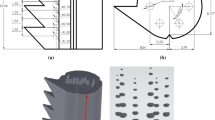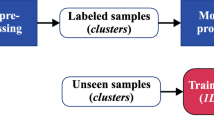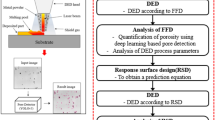Abstract
This study proposed deep learning-based ultrasonic nondestructive testing for porosity evaluation of additively manufactured components. First, porosity mechanisms according to additive manufacturing (AM) processing conditions were studied using traditional scanning acoustic microscopy and optical microscopy. Second, correlations between ultrasonic properties and porosity content were analyzed. The correlation results showed that the increased porosity content resulted in a decreased ultrasonic velocity and increased ultrasonic attenuation coefficient. Third, various levels of porosities were evaluated using a deep learning model based on a fully connected deep neural network that was trained on raw ultrasonic signals measured in the AM samples. After training, the testing performance of the trained model was evaluated. Additionally, the generalization performance of the pre-trained model was assessed using newly fabricated AM samples that were not used for training. The results showed that the porosity content evaluated by the pre-trained model matched well with that measured via traditional scanning acoustic microscopy, thus demonstrating the feasibility of deep learning-based ultrasonic nondestructive testing for porosity evaluation of additively manufactured components.












Similar content being viewed by others
References
Koester, L. W., Taheri, H., Bigelow, T. A., Collins, P. C., & Bonds, L. J. (2018). Nondestructive testing for metal parts fabricated using powder-based additive manufacturing. Materials Evaluation, 76(4), 514–524.
Ahn, D.-G. (2016). Direct metal additive manufacturing processes and their sustainable applications for green technology: A review. International Journal of Precision Engineering and Manufacturing-Green Technology, 3(4), 381–395.
Lee, H., Lim, C. H. J., Low, M. J., Tham, N., Murukeshan, V. M., & Kim, Y.-J. (2017). Lasers in additive manufacturing: A review. International Journal of Precision Engineering and Manufacturing-Green Technology, 4(3), 307–322.
Chua, Z. Y., Ahn, I. H., & Moon, S. K. (2017). Process monitoring and inspection systems in metal additive manufacturing: Status and applications. International Journal of Precision Engineering and Manufacturing-Green Technology, 4(2), 235–245.
Ng, G. K. L., Jarfors, A. E. W., Bi, G., & Zheng, H. Y. (2009). Porosity formation and gas bubble retention in laser metal deposition. Applied Physics a-Materials Science & Processing, 97(3), 641–649.
Eren, E., Kurama, S., & Solodov, I. (2012). Characterization of porosity and defect imaging in ceramic tile using ultrasonic inspections. Ceramics International, 38(3), 2145–2151.
Vergara, L., Miralles, R., Gosalbez, J., Juanes, F. J., Ullate, L. G., Anaya, J. J., et al. (2001). NDE ultrasonic methods to characterise the porosity of mortar. Ndt & E International, 34(8), 557–562.
Hernandez, M. G., Izquierdo, M. A. G., Ibanez, A., Anaya, J. J., & Ullate, L. G. (2000). Porosity estimation of concrete by ultrasonic NDE. Ultrasonics, 38(1–8), 531–533.
Li, W., Chen, B., Qing, X., & Cho, Y. (2019). Characterization of microstructural evolution by ultrasonic nonlinear parameters adjusted by attenuation factor. Metals, 9(3), 271.
Karthik, N. V., Gu, H., Pal, D., Starr, T., & Stucker, B. (2013). High frequency ultrasonic non destructive evaluation of additively manufactured components. In 24th International Solid Freeform Fabrication Symposium, 311–325.
Jeong, H. (1997). Effects of voids on the mechanical strength and ultrasonic attenuation of laminated composites. Journal of Composite Materials, 31(3), 276–292.
Kim, H. S., & Bush, M. B. (1999). The effects of grain size and porosity on the elastic modulus of nanocrystalline materials. Nanostructured Materials, 11(3), 361–367.
Turner, C. H., & Cowin, S. C. (1987). Dependence of elastic-constants of an anisotropic porous material upon porosity and fabric. Journal of Materials Science, 22(9), 3178–3184.
Slotwinski, J. A., Garboczi, E. J., & Hebenstreit, K. M. (2014). Porosity measurements and analysis for metal additive manufacturing process control. Journal of Research of the National Institute of Standards and Technology, 119, 494–528.
LeCun, Y., Bengio, Y., & Hinton, G. (2015). Deep learning. Nature, 521(7553), 436–444.
Nguyen, T. P., Choi, S., Park, S.-J., Park, S. H., & Yoon, J. (2020). Inspecting Method for Defective Casting Products with Convolutional Neural Network (CNN). International Journal of Precision Engineering and Manufacturing-Green Technology, 1–12.
Sambath, S., Nagaraj, P., Selvakumar, N., Arunachalam, S., & Page, T. (2010). Automatic detection of defects in ultrasonic testing using artificial neural network. International Journal of Microstructure and Materials Properties, 5(6), 561–574.
Trtnik, G., Kavcic, F., & Turk, G. (2009). Prediction of concrete strength using ultrasonic pulse velocity and artificial neural networks. Ultrasonics, 49(1), 53–60.
Harley, J. B., & Sparkman, D. (2019). Machine learning and NDE: Past, present, and future. AIP Conference Proceedings, 2102(1), 090001.
Ravanbod, H., & Jalali, A. (2008). Configurable ultrasonic flaw classification of oil pipelines. Nondestructive Testing and Evaluation, 23(1), 43–55.
Hou, W., Wei, Y., Guo, J., Jin, Y., & Zhu, C. A. (2018). Automatic detection of welding defects using deep neural network. Journal of Physics: Conference Series, 933(1), 012006.
Meng, M., Chua, Y. J., Wouterson, E., & Ong, C. P. K. (2017). Ultrasonic signal classification and imaging system for composite materials via deep convolutional neural networks. Neurocomputing, 257, 128–135.
Margrave, F. W., Rigas, K., Bradley, D. A., & Barrowcliffe, P. (1999). The use of neural networks in ultrasonic flaw detection. Measurement, 25(2), 143–154.
Yuan, S. F., Wang, L., & Peng, G. (2005). Neural network method based on a new damage signature for structural health monitoring. Thin-Walled Structures, 43(4), 553–563.
Fahad, M., Kamal, K., Zafar, T., Qayyum, R., Tariq, S., & Khan, K (2017). Corrosion detection in industrial pipes using guided acoustics and radial basis function neural network. In International Conference on Robotics and Automation Sciences (ICRAS), IEEE, 129–133.
Wang, Y., Shi, F., & Tong, X (2019). A Welding Defect Identification Approach in X-ray Images Based on Deep Convolutional Neural Networks. In International Conference on Intelligent Computing, springer(Cham), 53–64.
Isamail, L., Maskuri, N. L., Isip, N. J., Lokman, S. F., & Bakar, M. H. A. (2019). Deep Neural Network Modeling for Metallic Component Defects Using the Finite Element Model. In Progress in Engineering Technology, springer, 259–270.
Gong, H., Rafi, K., Gu, H., Starr, T., & Stucker, B. (2014). Analysis of defect generation in Ti–6Al–4V parts made using powder bed fusion additive manufacturing processes. Additive Manufacturing, 1, 87–98.
Peng, T., & Chen, C. (2018). Influence of energy density on energy demand and porosity of 316L stainless steel fabricated by selective laser melting. International Journal of Precision Engineering and Manufacturing-Green Technology, 5(1), 55–62.
Jhang, K.-Y., Choi, S., & Kim, J. (2020). Measurement of Nonlinear Ultrasonic Parameters from Higher Harmonics. In Measurement of Nonlinear Ultrasonic Characteristics..
Kim, J., Song, D.-G., & Jhang, K.-Y. (2017). Absolute measurement and relative measurement of ultrasonic nonlinear parameters. Research in Nondestructive Evaluation, 28(4), 211–225.
Park, S.-H., Kim, J., & Jhang, K.-Y. (2017). Relative measurement of the acoustic nonlinearity parameter using laser detection of an ultrasonic wave. International Journal of Precision Engineering and Manufacturing, 18(10), 1347–1352.
Park, S.-H., Kim, J., & Jhang, K.-Y. (2017). Measurement of absolute displacement-amplitude of ultrasonic wave using piezo-electric detection method. Journal of the Korean Society for Nondestructive Testing, 37(1), 7–12.
Jeong, H., & Hsu, D. K. (1995). Experimental-analysis of porosity-induced ultrasonic-attenuation and velocity change in carbon composites. Ultrasonics, 33(3), 195–203.
Ziółkowski, G., Chlebus, E., Szymczyk, P., & Kurzac, J. (2014). Application of X-ray CT method for discontinuity and porosity detection in 316L stainless steel parts produced with SLM technology. Archives of Civil and Mechanical Engineering, 14(4), 608–614.
Kasperovich, G., Haubrich, J., Gussone, J., & Requena, G. (2016). Correlation between porosity and processing parameters in TiAl6V4 produced by selective laser melting. Materials & Design, 105, 160–170.
Cunningham, R., Narra, S. P., Montgomery, C., Beuth, J., & Rollett, A. (2017). Synchrotron-based X-ray microtomography characterization of the effect of processing variables on porosity formation in laser power-bed additive manufacturing of Ti-6Al-4V. JOM Journal of the Minerals Metals and Materials Society, 69(3), 479–484.
Guo, C., Ge, W., & Lin, F. (2015). Effects of scanning parameters on material deposition during Electron Beam Selective Melting of Ti-6Al-4V powder. Journal of Materials Processing Technology, 217, 148–157.
Phani, K. K., & Niyogi, S. (1987). Elastic modulus-porosity relation in polycrystalline rare-earth oxides. Journal of the American Ceramic Society, 70(12), 362–366.
Zhu, K., Li, C. F., Zhu, Z. G., & Liu, C. S. (2007). Measurement of the dynamic Young’s modulus of porous titanium and Ti6Al4V. Journal of Materials Science, 42(17), 7348–7353. https://doi.org/10.1007/s10853-007-1532-y.
Hirsekorn, S., Van Andel, P., & Netzelmann, U. (1998). Ultrasonic methods to detect and evaluate damage in steel. Nondestructive Testing and Evaluation, 15(6), 373–393.
Yao, X. (1999). Evolving artificial neural networks. Proceedings of the IEEE, 87(9), 1423–1447.
Aldrin, J. C., & Forsyth, D. S. (2019). Demonstration of using signal feature extraction and deep learning neural networks with ultrasonic data for detecting challenging discontinuities in composite panels. In AIP Conference Proceedings.
Tokui, S., Oono, K., Hido, S., & Clayton, J. (2015). Chainer: a next-generation open source framework for deep learning. In Proceedings of workshop on machine learning systems (LearningSys) in the twenty-ninth annual conference on neural information processing systems (NIPS), 5, 1–6.
Javidrad, H., & Salemi, S. (2020). Determination of elastic constants of additive manufactured Inconel 625 specimens using an ultrasonic technique. International Journal of Advanced Manufacturing Technology, 107(11–12), 4597–4607.
Keskar, N. S., Mudigere, D., Nocedal, J., Smelyanskiy, M., & Tang, P. T. P. (2016). On large-batch training for deep learning: Generalization gap and sharp minima. arXiv preprint arXiv, 1609(04836).
Zech, J. R., Badgeley, M. A., Liu, M., Costa, A. B., Titano, J. J., & Oermann, E. K. (2018). Variable generalization performance of a deep learning model to detect pneumonia in chest radiographs: A cross-sectional study. Plos Medicine, 15(11).
Acknowledgements
This work was supported by a Korea Institute of Machinery & Materials grant funded by the Korea government (MSIT) (NK230l), and the Korea Institute of Energy Technology Evaluation and Planning (KETEP) and the Ministry of Trade, Industry and Energy (MOTIE) of the Republic of Korea (No. 20181510102360).
Author information
Authors and Affiliations
Corresponding authors
Ethics declarations
Conflict of interest
On behalf of all authors, the corresponding author states that there are no conflicts of interest.
Additional information
Publisher's Note
Springer Nature remains neutral with regard to jurisdictional claims in published maps and institutional affiliations.
Rights and permissions
About this article
Cite this article
Park, SH., Choi, S. & Jhang, KY. Porosity Evaluation of Additively Manufactured Components Using Deep Learning-based Ultrasonic Nondestructive Testing. Int. J. of Precis. Eng. and Manuf.-Green Tech. 9, 395–407 (2022). https://doi.org/10.1007/s40684-021-00319-6
Received:
Revised:
Accepted:
Published:
Issue Date:
DOI: https://doi.org/10.1007/s40684-021-00319-6




